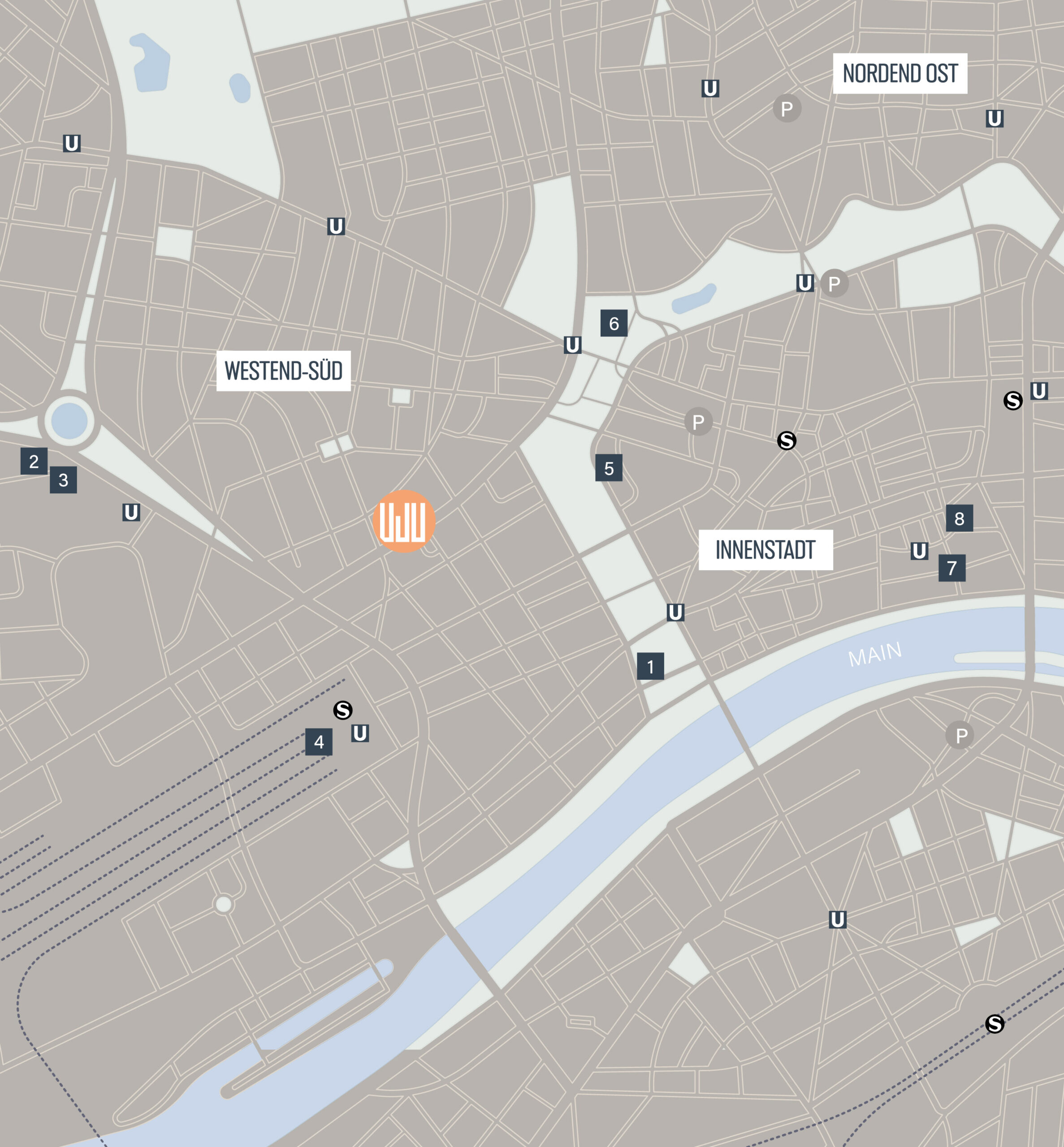
1 Frankfurt Opera
2 Frankfurt Trade Fair
3 Messe tower
4 Frankfurt central train station
5 Main Tower
6 Old Frankfurt Opera
7 Modern Art Museum
8 SCHIRN Art Museum Frankfurt
Perfectly accessible from all over the world
Central is another way of saying getting there fast. The VJU at Mainzer Landstraße 41-45 is characterised by short distances to all important facilities and is well connected to all transport routes. The central train station and the metro station Taunusanlage are only a five-minute walk away. Shopping facilities, many hotels and restaurants are also
located in the surrounding area, and the city centre can be reached in 10 minutes. The A5 and A66 motorways are not far off and the journey time to Frankfurt Airport is only about 14 minutes. Ideal conditions for employees and customers travelling to and from other parts of the city or the world.
Perfectly accessible from all over the world
Central is another way of saying getting there fast. The VJU at Mainzer Landstraße 41-45 is characterised by short distances to all important facilities and is well connected to all transport routes. The central train station and the metro station Taunusanlage are only a five-minute walk away. Shopping facilities, many hotels and restaurants are also located in the surrounding area, and the city centre can be reached in 10 minutes. The A5 and A66 motorways are not far off and the journey time to Frankfurt Airport is only about 14 minutes. Ideal conditions for employees and customers travelling to and from other parts of the city or the world.
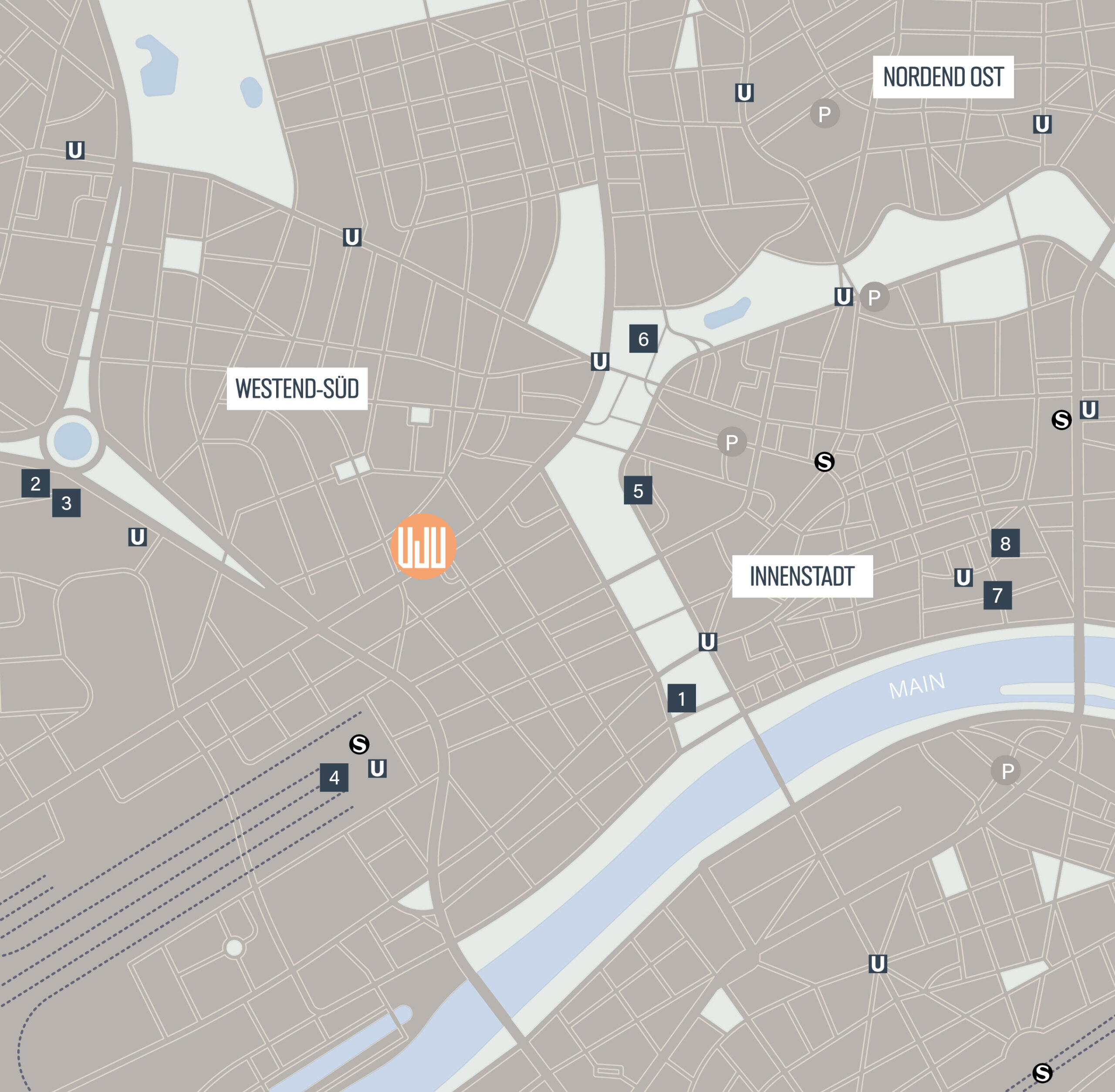
1 Frankfurt Opera
2 Frankfurt Trade Fair
3 Messe tower
4 Frankfurter central train station
5 Main Tower
6 Old Frankfurt Opera
7 Modern Art Museum
8 SCHIRN Art Museum Frankfurt
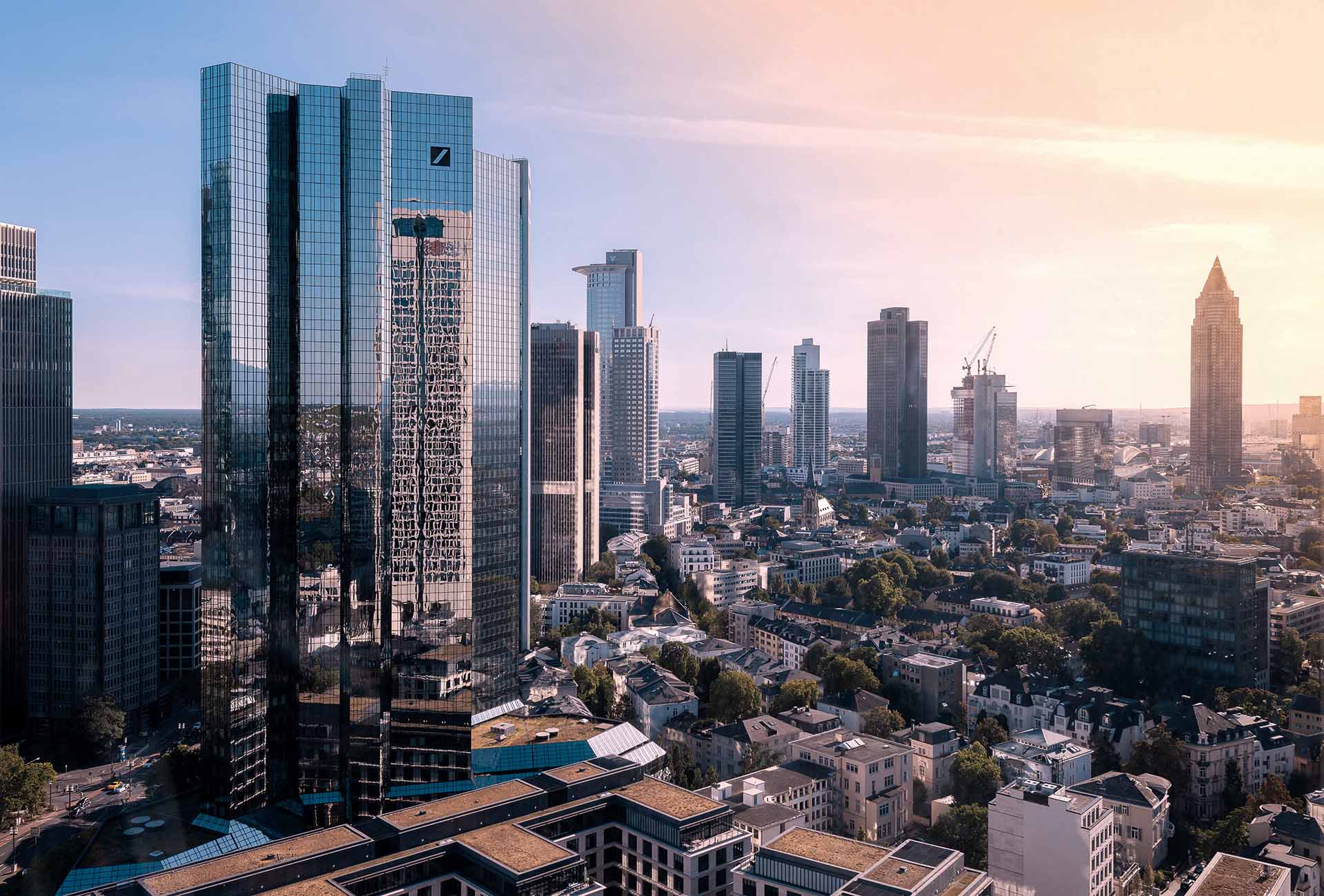
Eight kilometres of Frankfurt diversity
Modernity and history, living and working - Mainzer Landstraße has it all.
There is hardly any other street in Frankfurt where you can experience the Main metropolis in all its diversity. Anyone who takes a stroll along it from number 1 to 846 quickly realises that Frankfurt is much more than its office
towers reaching for the sky: there are bank headquarters, simple residential buildings as well as magnificent buildings from the turn of the century, some medieval architecture at the Galluswarte, a lot of city traffic, a lot of urbanity, a lot of international flair. Mainzer Landstraße
crosses the districts of Westend, Bahnhofsviertel, Gallus, Griesheim, Nied. It starts as part of the ring-shaped Wall Park at Taunusanlage with the Old Opera house, the twin towers of Deutsche Bank, past the Trade Fair, Friedrich-Ebert- Anlage and Platz der Republik until it ends exactly 8.3 kms later at the Niddam mouth of the Main River.
A modern landmark
The VJU is more than just functional. It offers new perspectives.
In the past, around the middle of the 18th century, people travelled to Mainz along the second longest road in the city, which was one of the first to be developed and paved as an avenue. Mainzer Landstraße today still remains an important connecting axis between the city centre and the western parts of the city. And just as it was already home to important
commercial enterprises and factories in the 19th century, Mainzer Landstraße is still a leading business location and is characterised by large financial institutions, consulting firms and insurance companies in the banking district.
Mainzer Landstraße largely runs in parallel to the Main River
A modern landmark
The VJU is more than just functional. It offers new perspectives.
In the past, around the middle of the 18th century, people travelled to Mainz along the second longest road in the city, which was one of the first to be developed and paved as an avenue. Mainzer Landstraße today still remains an important connecting axis between the city centre and the western parts of the city. And just as it was already home to important commercial enterprises and factories in the 19th century, Mainzer Landstraße is still a leading business location and is characterised by large financial institutions, consulting firms and insurance companies in the banking district.
Mainzer Landstraße largely runs in parallel to the Main River


Around the VJU
Gastronomy
1 THE IVORY CLUB Taunusanlage 15
2 ZENZAKAN Taunusanlage 15
3 MORIKI Taunusanlage 12
4 KABUKI Kaiserstraße 42
5 H’UGO’S Neue Rothofstraße 21
6 ZARGES Kalbächer G. 10
7 THE KINLY BAR Elbestraße 34
8 EBERT‘S SUPPENSTUBE Große Bockenheimer Str. 31
9 VEVAY Neue Mainzer Str. 20
10 STEIGENBERGER FRANKFURTER HOF Am Kaiserplatz
11 KLEINMARKTHALLE Hasengasse 5-7
12 CHINASKI Bockenheimer Landstraße 3
13 MAXIE EISEN Münchener Str. 18
14 MAIN NIZZA Untermainkai 17
15 WACKER’S KAFFEE Kornmarkt 9
16 ZUM SCHWARZEN STERN Römerberg 6
17 GEKKO‘S Hochstraße 4
18 SULLIVAN BAR Kaiserstraße 12
19 OSCAR’S BRASSERIE Steigenberger Frankfurter Hof
20 KAMEHA SUITE Taunusanlage 20
21 AMOROSO Opernplatz 8
22 THE PARLOUR Zwingergasse 6
23 MARGARETE Braubachstraße 18
24 RESTAURANT OPÉRA Opernplatz 1
25 EATDOORI Oeder Weg 30
26 LE VINGTNEUF Elbestraße 29
Around the VJU
Gastronomy
1 THE IVORY CLUB Taunusanlage 15
2 ZENZAKAN Taunusanlage 15
3 MORIKI Taunusanlage 12
4 KABUKI Kaiserstraße 42
5 H’UGO’S Neue Rothofstraße 21
6 ZARGES Kalbächer G. 10
7 THE KINLY BAR Elbestraße 34
8 EBERT‘S SUPPENSTUBE Große Bockenheimer Str. 31
9 VEVAY Neue Mainzer Str. 20
10 STEIGENBERGER FRANKFURTER HOF Am Kaiserplatz
11 KLEINMARKTHALLE Hasengasse 5-7
12 CHINASKI Bockenheimer Landstraße 3
13 MAXIE EISEN Münchener Str. 18
14 MAIN NIZZA Untermainkai 17
15 WACKER’S KAFFEE Kornmarkt 9
16 ZUM SCHWARZEN STERN Römerberg 6
17 GEKKO‘S Hochstraße 4
18 SULLIVAN BAR Kaiserstraße 12
19 OSCAR’S BRASSERIE Steigenberger Frankfurter Hof
20 KAMEHA SUITE Taunusanlage 20
21 AMOROSO Opernplatz 8
22 THE PARLOUR Zwingergasse 6
23 MARGARETE Braubachstraße 18
24 RESTAURANT OPÉRA Opernplatz 1
25 EATDOORI Oeder Weg 30
26 LE VINGTNEUF Elbestraße 29


Innovators invented progressive solutions on Mainzer Landstraße
History creates identification. Where do we come from? Where are we headed? One thing seems inconceivable without the other. Thus, the history of Mainzer Landstraße also characterises the location as a central, sought-after business district, as a calling card for companies with a character and a vision. Other pioneers have already invented progressive solutions on Mainzer Landstraße and advanced the world a little bit with them. Some of the entrepreneurs based on Mainzer Landstraße even had their own railway connections in the early 19th century, which led directly to the doorsteps of their business premises.
To this day, isolated pieces of track from this period can still be found in the ground. One of the first factories on Mainzer Landstraße was the bronze factory F. A. Junge. However, it was Harry Fuld, who together with
Carl Lehner - later a senator in Frankfurt - founded Priteg, the Deutsche Privat-Telephon-Gesellschaft H. Fuld & Co in Mainzer Landstraße (first No. 193, then No. 140.), who achieved international importance. The company‘s success was based on self-developed telephone systems with up to 32,000 extensions, as well as their installation, support and rental. The two businessmen transformed the company into one of the largest manufacturers of communication equipment in Germany. Shortly after Fuld‘s death in the 1930s, the Deutsche Privat-Telephon Gesellschaft H. Fuld & Co became Telefonbau und Normalzeit, or Telenorma or T&N for short.
City of superlatives
Population: approx. 764,000
Frankfurt Rhine-Main area
With a population of almost 6 million,it is one of Europe‘s leading cities.
Data centre capital of Europe
The largest Internet node in the world, DE-CIX, is located in the metropolis on the Main River. Frankfurt is positioning itself alongside Amsterdam, Dublin, Luxembourg and Paris as the financial capital of Europe. Frankfurt is an
international financial hub and home
to the European Central Bank, the
European Insurance and Occupational Pensions Authority and the European Banking Authority.
Leading location for banks and financial institutions
These include Deutsche Bank, Commerzbank, DZ Bank and numerous representative offices of foreign banks such as Goldman Sachs and Morgan Stanley.
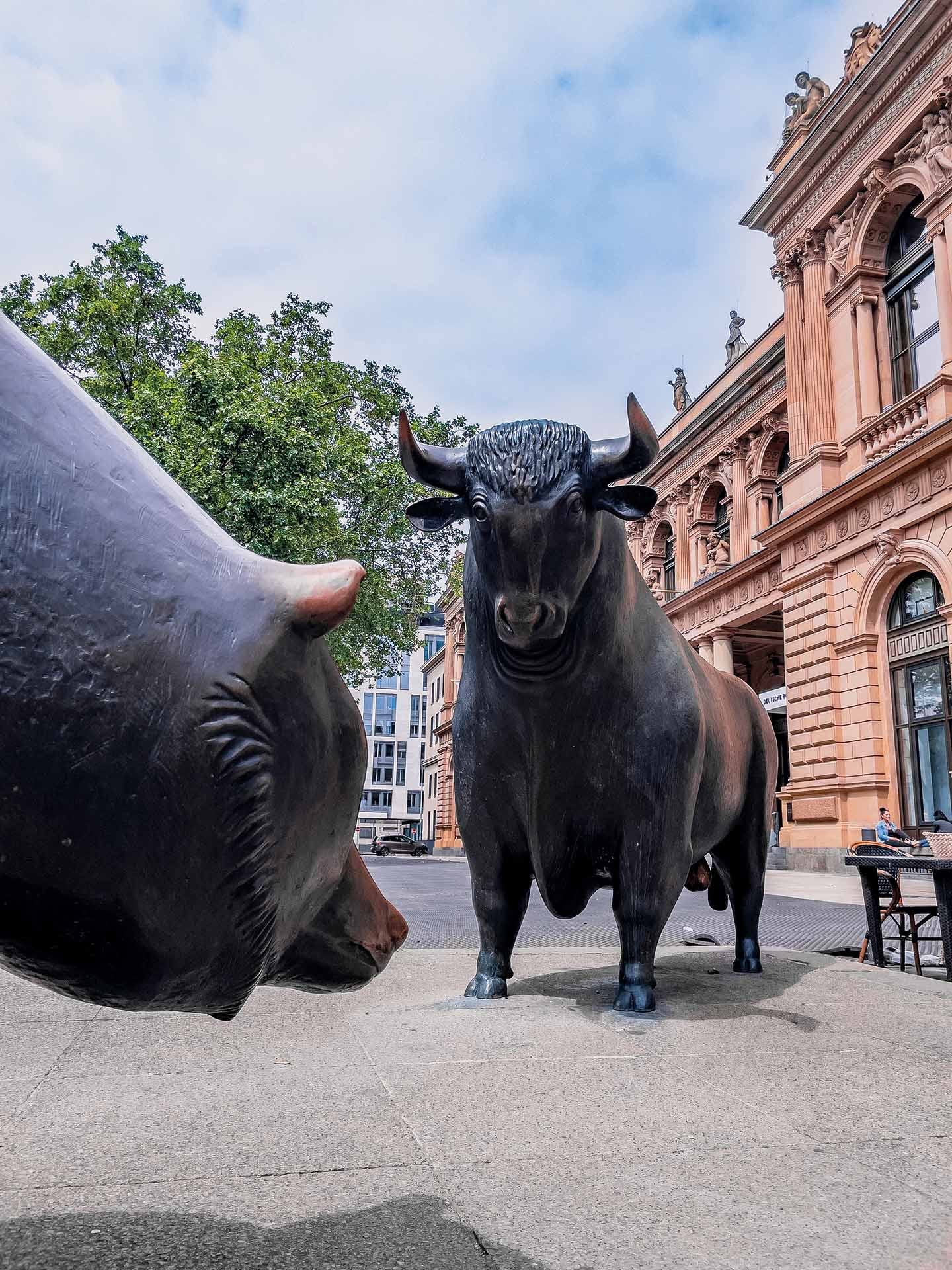

City of superlatives
Population: approx. 764,000
Frankfurt Rhine-Main area
With a population of almost 6 million,it is one of Europe‘s leading cities.
Data centre capital of Europe
The largest Internet node in the world, DE-CIX, is located in the metropolis on the Main River. Frankfurt is positioning itself alongside Amsterdam, Dublin, Luxembourg and Paris as the financial capital of Europe. Frankfurt is an international financial hub and home to the European Central Bank, the European Insurance and Occupational Pensions Authority and the European Banking Authority.
Leading location for banks and financial institutions
These include Deutsche Bank, Commerzbank, DZ Bank and numerous representative offices of foreign banks such as Goldman Sachs and Morgan Stanley.



The Frankfurt am Main railway station is one of the busiest in Europe. Due to its central location, Deutsche Bahn describes it as the most important transport hub in German rail traffic.
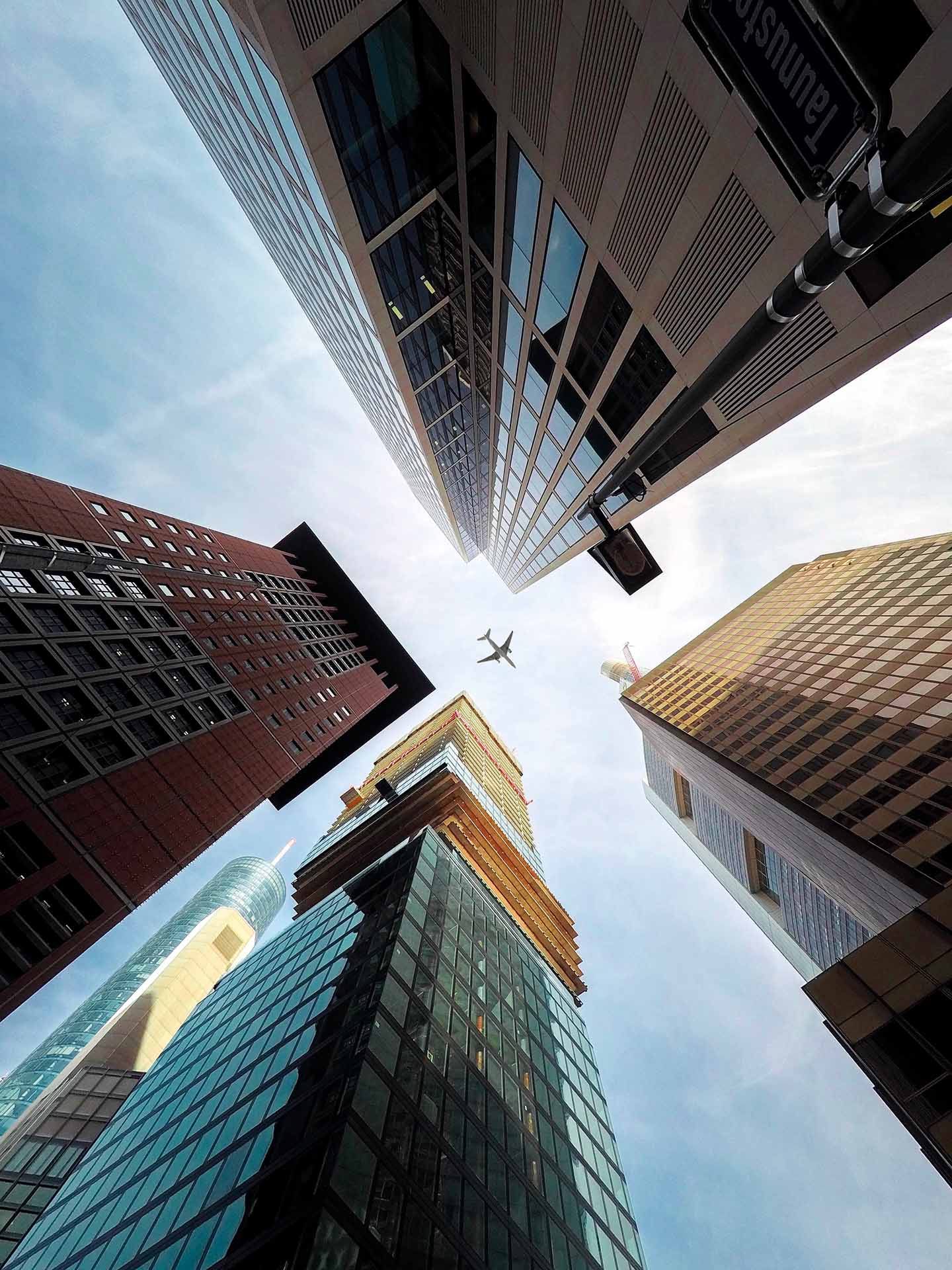
Frankfurt‘s essence is its cosmopolitan flair with connections to the whole world.
Oldest and one of the largest trade fairs in the world
The history of the Frankfurt Trade Fair dates back more than 700 years. Frankfurt has the world‘s second largest trade fair grounds after Shanghai.
International hub
Frankfurt Airport is an international hub for freight and passenger traffic. With 155 airlines, 4,400 flights to over 300 destinations in 110 countries and
over 70 million passengers a year, it is Germany‘s largest passenger airport.
One of Germany‘s busiest railway stations
The strategic location of the station in the centre of Europe makes it attractive for long-distance trains from major cities in the EU. Officially inaugurated in August 1888, it is also one of the oldest railway stations in the country.
Frankfurt has everything it needs to be prepared for the future
Frankfurt has everything it needs to be prepared for the future

The Frankfurt am Main railway station is one of the busiest in Europe. Due to its central location, Deutsche Bahn describes it as the most important transport hub in German rail traffic.

Frankfurt‘s essence is its cosmopolitan flair with connections to the whole world.
Oldest and one of the largest trade fairs in the world
The history of the Frankfurt Trade Fair dates back more than 700 years. Frankfurt has the world‘s second largest trade fair grounds after Shanghai.
International hub
Frankfurt Airport is an international hub for freight and passenger traffic. With 155 airlines, 4,400 flights to over 300 destinations in 110 countries and over 70 million passengers a year, it is Germany‘s largest passenger airport.
One of Germany‘s busiest railway stations
The strategic location of the station in the centre of Europe makes it attractive for long-distance trains from major cities in the EU. Officially inaugurated in August 1888, it is also one of the oldest railway stations in the country.